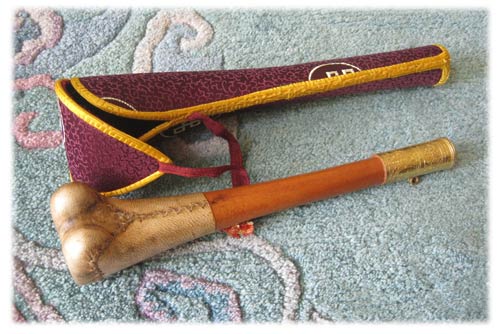Shing Kangling
The thigh bone trumpet or kangling is an essential implement of Chod, and has many meanings and subtle functions for the practitioner. Most Westerners, however, are not aware that if one does not have a human bone kangling, one can effectively use their own curled hand to blow through! Additionally, both wood and certain horn kanglings are acceptable and correct methods of practice.
As stated in the definitive Mindroling Manual of Vajrayana Implements and Dharma Objects (Nyagur Nyingma College, 2003):
“Formerly in Tibet, at some monastic centers at various periods, the traditions of sounding the thighbone horn, wood kangling and deer kangling were renowned.”
The creation of our specially hand-crafted wooden (Tib: shing) kanglings has surpassed all expectation! They are exquisite and unique, from the fine finish and vibrant sound, to the sturdy brocade case.
Features of Wood Kangling
- Made of Sengdeng (Acacia), the same dense and resonant wood used to make the traditional Chod damaru.
- The sound is brilliantly clear and easier to play than the bone kangling.
- The mouthpiece is made of hand molded brass, scribed with three types of decaying heads, fresh, rotting and dried skull, representing the three kayas, as in a katvanga.
- The skin around the head is made of goat and white in color.
- It has the same energetic and tsa-lung effects as a bone damaru, and carries your own energetic signature of wind through your hand bones.
- They contain internal beeswax coating, just like a bone damaru, as a moisture barrier and to make the sound more resonant.
- A stiff high-quality case is included, nothing like the flimsy, cheap cases available in Nepal and India.
Advantages of Shing Kangling
- There is no problem whatsoever with transport or visibility in public as with human bone.
- Bone kanglings are almost never from a known origin and often not from reliable sources. For example, kangling are not to be used from diseased individuals or who died from contagion, those who died from an accident, heretics, non-Buddhists or samaya breakers, etc.
- They are less wrathful and gentler in action, since they carry only your own life energy-signature.
The price is comparatively reasonable and affordable. - They are not subject to cracks or damage, as with fragile bone.
- Wood also retains ones drupa or siddhi, the accumulated positive energy of practice.
- They are a work of art that can last a lifetime and be passed on as a sacred legacy to future practitioners.
As with all wood carvings, each has slightly different grain and wood texture. Each of these, hand-crafted by our Bhutanese artisan who is a serious Chod and Troma practitioner, takes time to create. Thus they are available in limited supply and not always in stock.
Bone vs Wood Kangling
The energetic effect of bone and wood is identical (since you are blowing threw the bone of your hand in both cases). In fact, traditionally if one does not have a kangling, one can glow through the rolled up fingers, as a make-shift horn, emulating the sound of the natural kangling with one’s voice. Practitioners should know all these facts, and much more about the nature of kangling, before becoming “bone snobs” and holding the wrong view that wood kangling are inferior to bone kangling.



KPICASA_GALLERY (WoodKangling)

